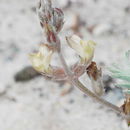Comprehensive Description
provided by North American Flora
Batidophaca humistrata (A. Gray) Rydberg
Astragalus humislratus A. Gray, PI. Wright. 2: 43. 1853.
Tragacantha humistrata Kuntze. Rev. Gen. 945. 1891.
Tium huministralum Rydb. Bull. Torrey Club 32: 660. 1905.
A perennial, with a cespitose caudex ; stems several, branched, decumbent, terete, sparingly pilose with ascending or appressed hairs; leaves 4—5 cm. long, ascending, green; petioles 5-15 mm. long; stipules deltoid, 5-S mm. long, connate around the stem, united three fourths their length, membranous, slightly pubescent; leaflets 13-19, oblong or rarely lance-oblong, obtuse, acute, or mucronate, 8-18 mm. long, 2-4 mm. wide, glabrate above, sparingly pilose with ascending hairs beneath; peduncles 3-8 cm. long; racemes 2-6 cm. long, rather dense; bracts lanceolate, 5-8 mm. long; calyx sparingly pilose, the tube 3 mm. long, the teeth subulate, 4 mm. long; corolla purplish to dirty-white, 10-12 mm. long; banner obovate, retuse, veined; wings nearly as long, the blade obliquely oblong, with a rounded auricle; keel-petals slightly shorter, the blade strongly arched at the middle, with a lance-triangular, but blunt tip; pod 15-20 mm. long, strigose, arcuate, acuminate at the apex, blunt at the base, laterally compiessed at the apex, the upper suture acute throughout, the lower one acute at the apex, sulcate at the middle, and rather flat at the base.
Type locality: Copper Mines [Santa Rita del Cobre], New Mexico. Distribution: Southern Colorado to Chihuahua and Arizona.
- bibliographic citation
- Per Axel Rydberg. 1919. (ROSALES); FABACEAE; PSORALEAE. North American flora. vol 24(1). New York Botanical Garden, New York, NY
Comprehensive Description
provided by North American Flora
Pisophaca datilensis Rydberg, sp. nov
A cespitose perennia' ; stems decumbent at the base, 2-3 dm. high, sparingly strigose with rather long hairs; leaves spreading, 4—7 cm. long; stipules lance-deltoid, long-acuminate, 5-6 mm. long; leaflets 11-15, oblong-oblanceolate, abruptly short-acuminate at the apex, acute at the base, 5—1 S mm. long, 2-5 mm. wide, green, sparingly strigose beneath, glabrous above; peduncles 5-6 cm. long; racemes 2-3 cm. long; bracts lanceolate, about 5 mm. long; pedicels 1 mm. long; calyx long-strigose, the tube 4 mm. long, 3 mm. wide, the teeth 3.5 mm. long, lanceolate; coro'la light-purple, fully 1 cm. long; banner bioadly obovate; wings nearly as long, the blade oblanceolate, slightly falcate, with a large basal auricle; keel-petals much shorter, the blade obliquely obovate, rounded at the apex; pod ovoid-elliptic, sparingly strigose, obtuse at the base, acute at the apex, sessile, 12-15 mm. long, 5 mm. wide and thick.
Type collected at Negrito Ranger Station, Datil Forest, New Mexico, September 22, 1919, Eggleslon, 16087 (herb. N. Y. Bot. Gard.).
- bibliographic citation
- Per Axel Rydberg. 1919. (ROSALES); FABACEAE; PSORALEAE. North American flora. vol 24(1). New York Botanical Garden, New York, NY
Physical Description
provided by USDA PLANTS text
Perennial, Herbs, Stems woody below, or from woody crown or caudex, Taproot present, Nodules present, Stems or branches arching, spreading or decumbent, Stems prostrate, trailing, or mat forming, Stems less than 1 m tall, Stems solid, Stems or young twigs sparsely to densely hairy, Stems with 2-branched hairs, dolabriform, Leaves alternate, Leaves petiolat e, Stipules conspicuous, Stipules membranous or chartaceous, Stipules persistent, Stipules connate to each other, forming a tuber or sheath, Leaves compound, Leaves odd pinnate, Leaf or leaflet margins entire, Leaflets opposite, Leaflets 10-many, Leaves hairy on one or both surfaces, Flowers in axillary clusters or few-floweredracemes, 2-6 flowers, Inflorescences racemes, Inflorescence axillary, Bracts very small, absent or caducous, Flowers zygomorphic, Calyx 5-lobed, Calyx glabrous, Petals separate, Corolla papilionaceous, Petals clawed, Petals white, Petals ochroleucous, cream colored, Petals greenish yellow, Banner petal narrow or oblanceolate, Wing petals narrow, oblanceolate to oblong, Wing tips obtuse or rounded, Keel petals auriculate, spurred, or gibbous, Keel tips obtuse or rounded, not beaked, Stamens 9-10, Stamens diadelphous, 9 united, 1 free, Filaments glabrous, Style terete, Style persistent in fruit, Fruit a legume, Fruit unilocular, Fruit tardily or weakly d ehiscent, Fruit elongate, straight, Fruit oblong or ellipsoidal, Fruit strongly curved, falcate, bent, or lunate, Fruit exserted from calyx, Fruit beaked, Fruit hairy, Fruit 3-10 seeded, Fruit 11-many seeded, Seeds cordiform, mit-shaped, notched at one end, Seed surface smooth, Seeds olive, brown, or black.

